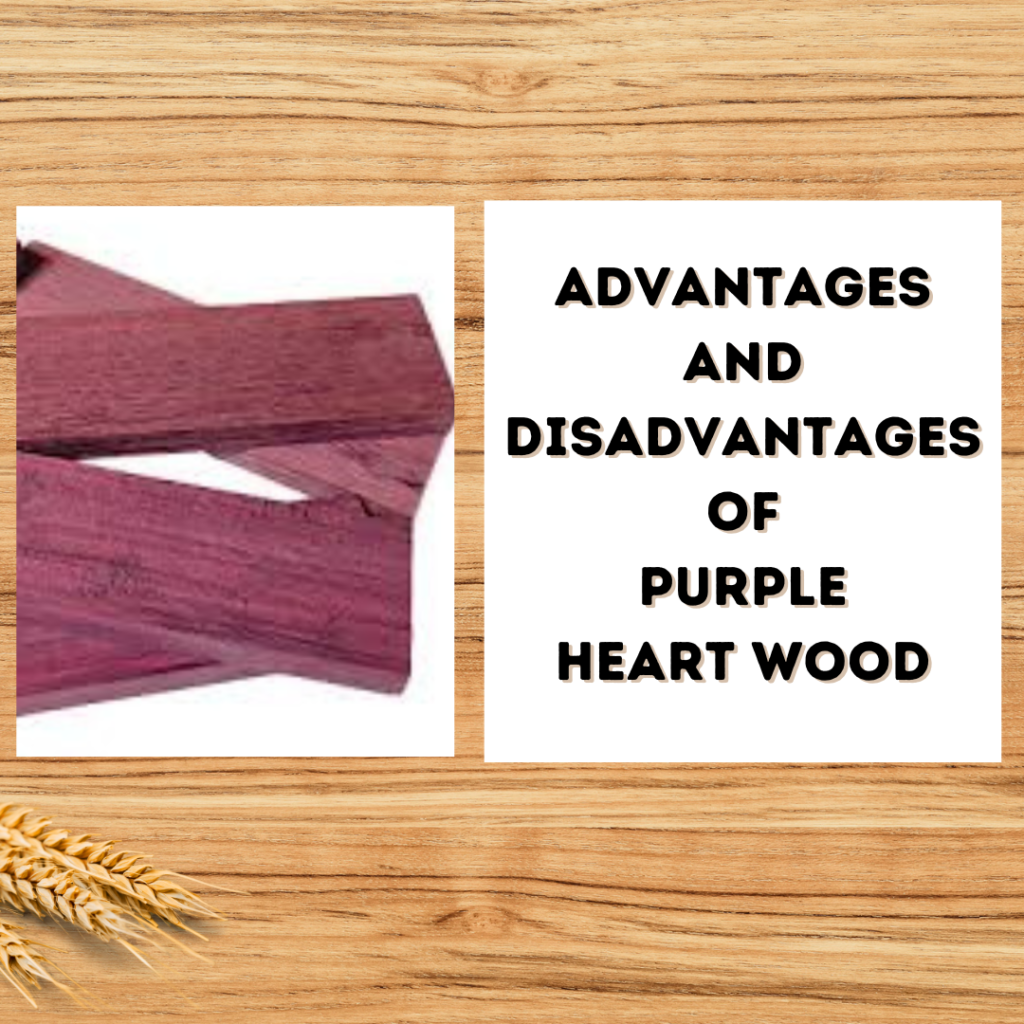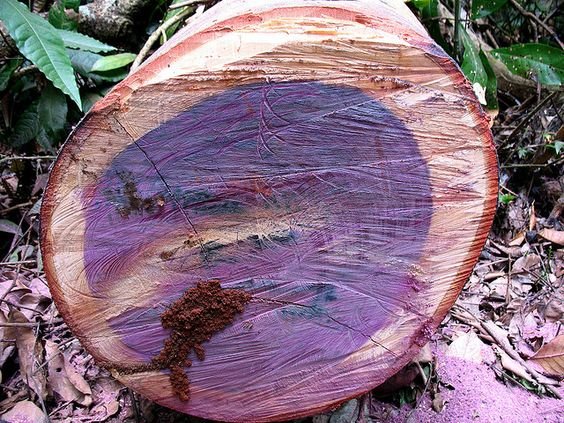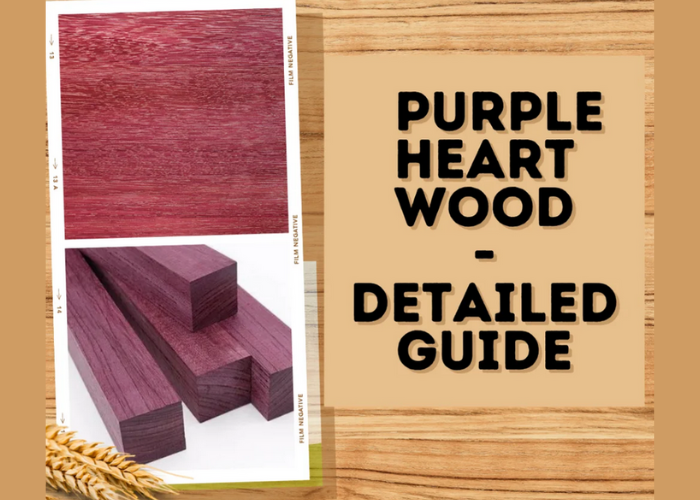Purple Heart Wood
Explore the magic of Purple Heart Wood! People love it for its bright colors and special designs, so it’s popular with furniture makers and DIY enthusiasts. This guide talks about where it comes from and how it’s used in woodworking. Let’s learn more about the beauty of Purple Heart Wood!
History and Origin :
Discover the fascinating story behind Purple Heart Wood, also known as Peltogyne (commonly known as purpleheart, violet wood, amaranth). This unique type of wood has become increasingly popular in recent years thanks to its eye-catching purple color. But there’s more to it than meets the eye!
This Wood originates from the tropical regions of Central and South America, specifically from the tall Peltogyne trees that can reach heights of up to 130 feet with diameters averaging 2-3 feet. These trees thrive in countries like Brazil, Bolivia, Peru, and Venezuela.
Its history traces back to ancient times when indigenous tribes utilized it for various purposes. The Incas used it in construction, while the Mayans valued its durability for crafting weapons and tools. They also believed in its healing properties.
During the colonial era, European explorers were captivated by the wood’s deep purple hue, often referring to it as amaranth or violetwood. Queen Elizabeth I even had a bed made entirely from Purple Heart Wood.
Over time, this wood gained traction in furniture making due to its unique color and robustness. In the early 20th century, its significance grew further during World War I when soldiers wounded in battle were honored with the “Order of the Purple Heart” medal, crafted from this extraordinary wood.
Physical Characteristics and Properties :
Color: This type of Wood is known for its striking purple color, although this can change to reddish-brown with age or depending on where it was grown. Over time, it might darken to a deeper purple or even black.
Grain: The grain of this Wood is interlocked, with a texture that feels smooth to the touch. This makes it easy to work with using hand tools or machines.
Density: It is very dense, with a density of 0.85 g/cm3 (or 53 lbs/ft3). This makes it one of the densest woods used commercially. Its heavy weight contributes to its durability, making it tough against dents and scratches.
Durability: This Wood is incredibly durable, known for its exceptional strength and resistance to decay. With a Janka hardness rating of 2,520 lbf (pounds force), it ranks among the toughest woods globally. This durability makes it perfect for outdoor projects like decking or fencing.
Moisture Resistance: It has a remarkable trait: it naturally resists moisture. Unlike many other woods that warp or crack when they get wet or are in humid environments, this hardwood stays stable.
Stability: Because of its density and interlocked grain pattern, Purple Heart Wood doesn’t move much once it’s dried correctly. This makes items made from this wood less likely to warp or shrink over time, which is why it’s great for furniture and flooring.
Workability: Even though this Wood is very dense, it’s still quite manageable to work with. You can sand it smoothly and polish it for a shiny finish. However, because it’s hard, you might need to pre-drill before nailing or screwing it.
Advantages and Disadvantages of Working with Purple Heart Wood :

Advantages:
1. Stunning Color: One big benefit of using Purple Heart wood is its amazing purple color. This color isn’t from stains or paint; it comes from the wood’s natural pigments. This makes each piece unique and adds a lovely look to any project.
2. Hardness: Another great thing about this wood is its toughness. It’s one of the hardest woods in the world, so it doesn’t get damaged easily. This makes it perfect for furniture that gets a lot of use or for outdoor projects that have to handle rough weather.
3. Decay Resistance: Because it’s very dense and has natural oils, this wood doesn’t decay or rot easily. This makes it an excellent choice for outdoor furniture or structures that are often exposed to moisture.
4. Easy Maintenance: Thanks to its durability, this wood needs very little maintenance. Unlike other woods like pine or cedar, which often need regular sealing or staining, Purple Heart wood stays in good condition with less upkeep.
5.Budget-Friendly: Even though it’s a high-quality hardwood, this wood is quite affordable compared to other exotic woods like teak or mahogany.
Disadvantages:
1. Difficulty in Cutting: As noted before, one benefit of this wood is its hardness. However, this can also be a downside because it makes cutting and shaping more difficult compared to softer woods.
2. Fragility when Dried Too Quickly: If the wood isn’t dried slowly and properly, it can become brittle and crack or splinter easily. So, it’s important to take care when drying and storing this type of wood.
3.Tendency to Bleed: Because of its natural pigments, Purple Heart wood can bleed or release color when it gets wet. This can be a problem if you’re working with light-colored woods or fabrics, as it might stain them.
4. Possible Irritation: Handling Purple Heart wood can lead to skin irritation for some individuals due to its high tannin content. While severe reactions are rare, purpleheart wood has been known to sensitize people. Typical symptoms include eye and skin irritation, and in some cases, nausea. It’s crucial to take precautions when working with purpleheart wood and follow safety guidelines for wood allergies and toxicity.
How to Identify Authentic Purple Heart Wood ?

1. Look at the Color:
The most noticeable feature of real Purple Heart wood is its bright purple color. The shade can vary a bit depending on the wood’s age and quality, but it should always be a rich, deep purple without any brown or gray mixed in.
2. Check for Grain Pattern:
Real Purple Heart Wood has a unique grain pattern that looks like stripes or waves in the wood. This pattern comes from how the tree grows and can look different from one piece to another. If you find wood that says it’s Purple Heart but doesn’t have this grain pattern, it’s probably fake.
3. Feel the Weight:
You can also tell if wood is real Purple Heart by its weight. Since it’s dense, it’s heavier than many other woods like oak or pine. If a piece of wood that’s supposed to be Purple Heart feels light or weak, it might not be real.
4. Check for Natural Imperfections:
Just like any natural material, genuine Purple Heart Wood will have imperfections such as knots or cracks in its grain pattern. These marks give each piece its own character and uniqueness, and they’re difficult to imitate on fake versions.
5. Smell Test:
A straightforward way to tell if wood is real purple heart is by smelling it! Genuine purple heartwood has a sweet scent that fake materials can’t replicate.
6. Conduct an Acidity Test:
If you’re still unsure whether your wood is real purple heartwood, you can try a simple acidity test. Put a little vinegar on the wood in a hidden spot. If the wood turns a deep burgundy color, it’s probably genuine purple heart wood.
Interesting Facts and Myths about Purple Heart Wood :
Fact #1: Origin and Distribution
The first thing to know about Purple Heart Wood is where it comes from. It’s originally from Central and South America, especially countries like Brazil, Peru, and Bolivia. The tree that makes this wood can grow up to 120 feet tall with a trunk that’s 3-4 feet wide. What’s interesting is, it only gets its bright purple color when it’s in sunlight; otherwise, it looks kind of pale brown.
Myth #1: Healing Properties
A common myth about Purple Heart Wood is its believed healing powers. Some cultures think that wearing jewelry made from this wood can bring good luck and guard against sickness. Although there might be cultural meaning tied to using this wood in some communities, there’s no scientific proof that Purple Heart Wood has any healing properties.
Fact #2: Durability
Even though it’s lighter than many other hardwoods (about 47 pounds per cubic foot), this wood is super tough. It has a hardness rating of 2,500 pounds-force on the Janka scale, making it one of the hardest woods out there. This hardness means it’s hard to scratch or dent, so it’s great for places with lots of foot traffic, like floors.
Myth #2: Toxicity
There are some claims online saying that Purple Heart Wood might be toxic because of the natural chemicals that make it purple, called quinones. However, there haven’t been any cases reported of it being toxic. Still, it’s always smart to be safe when working with any kind of wood. So, make sure to wear a mask and have good ventilation when doing woodworking projects.
Fact #3: Sustainability
Another cool thing about Purple Heart Wood is that it’s seen as a sustainable option for woodworking. The tree it comes from, Peltogyne spp., grows a lot in its home areas and doesn’t need replanting or a lot of extra care. So, it’s a good choice for people who want eco-friendly materials.
Myth #3: Limited Availability
Although these woods might appear rare and exotic, it’s actually quite easy to find in the market. Its popularity has grown over time, so many suppliers now offer this wood. However, being careful about where you buy your Purple Heart Wood from ensures that you get high-quality pieces without supporting illegal logging practices.
Also read: Hickory Wood: Everything You Need to Know

